The document discusses various types of sensors, their classifications, and applications in fields such as industrial automation, medical devices, and consumer electronics. It details criteria for selecting sensors, highlights different types including temperature, infrared, ultraviolet, touch, and proximity sensors, and examines their operational principles. The text also explores advanced sensor technologies like barcode and electromagnetic identification, emphasizing the importance of sensors in enhancing system efficiency and performance.
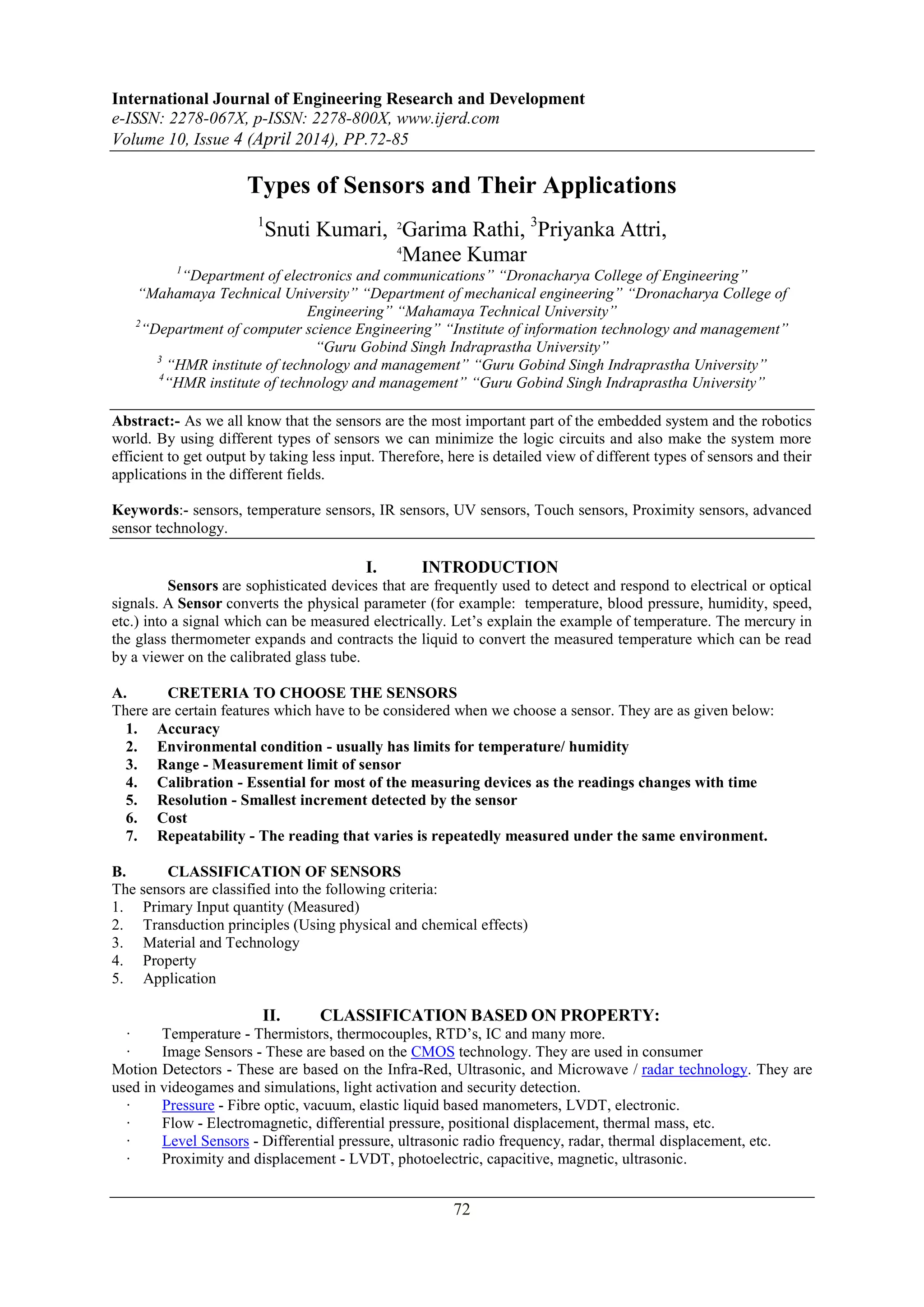
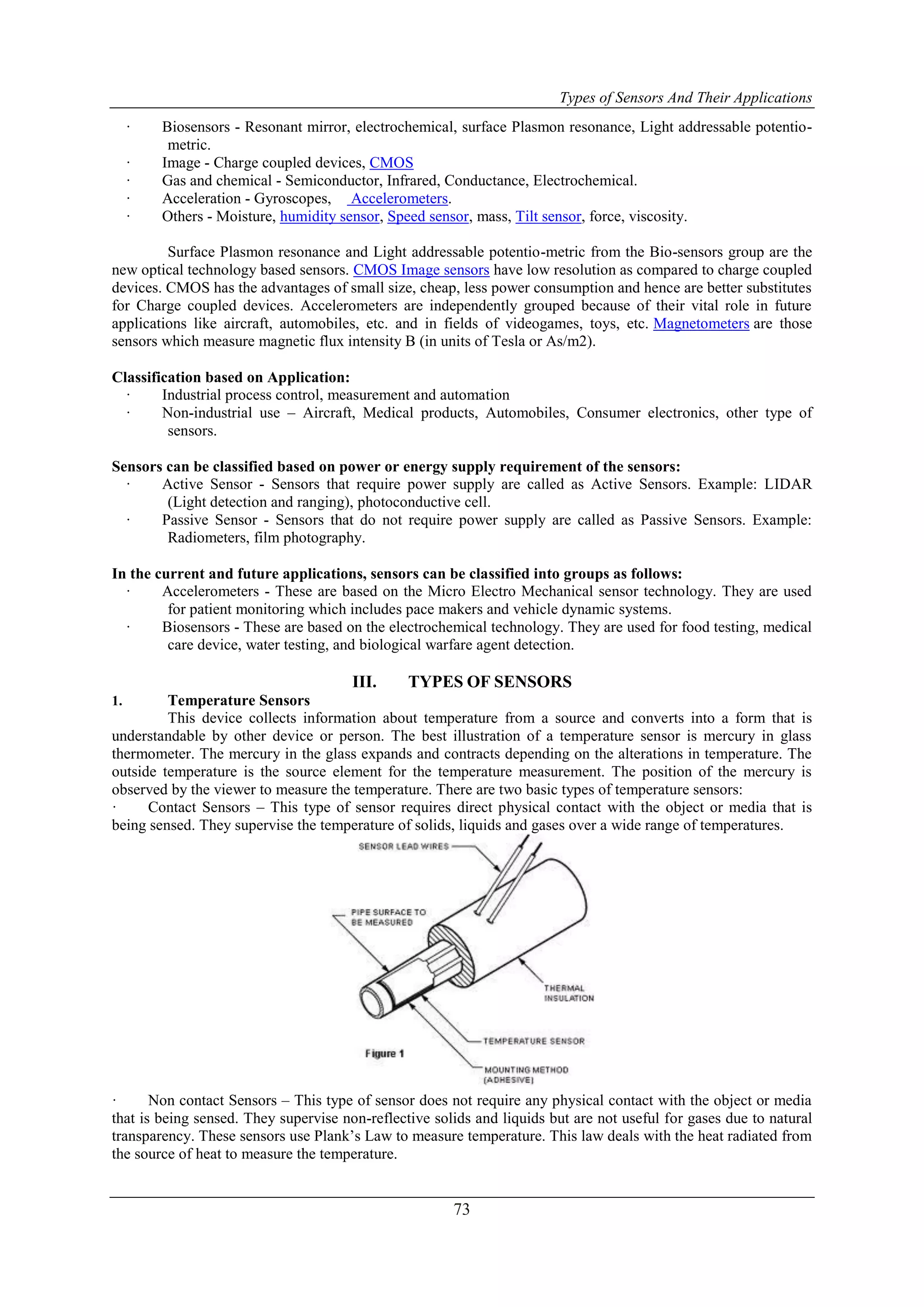
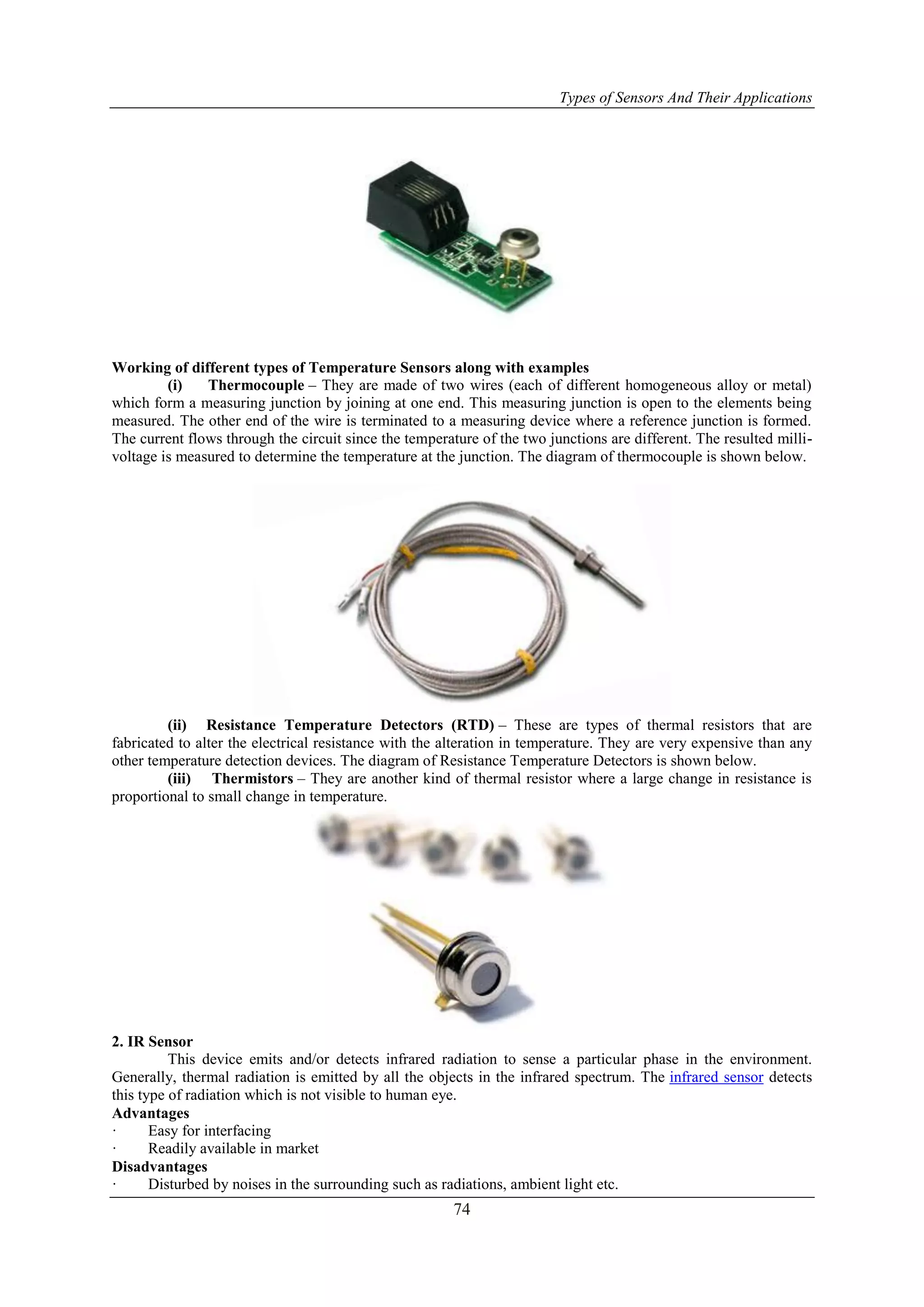
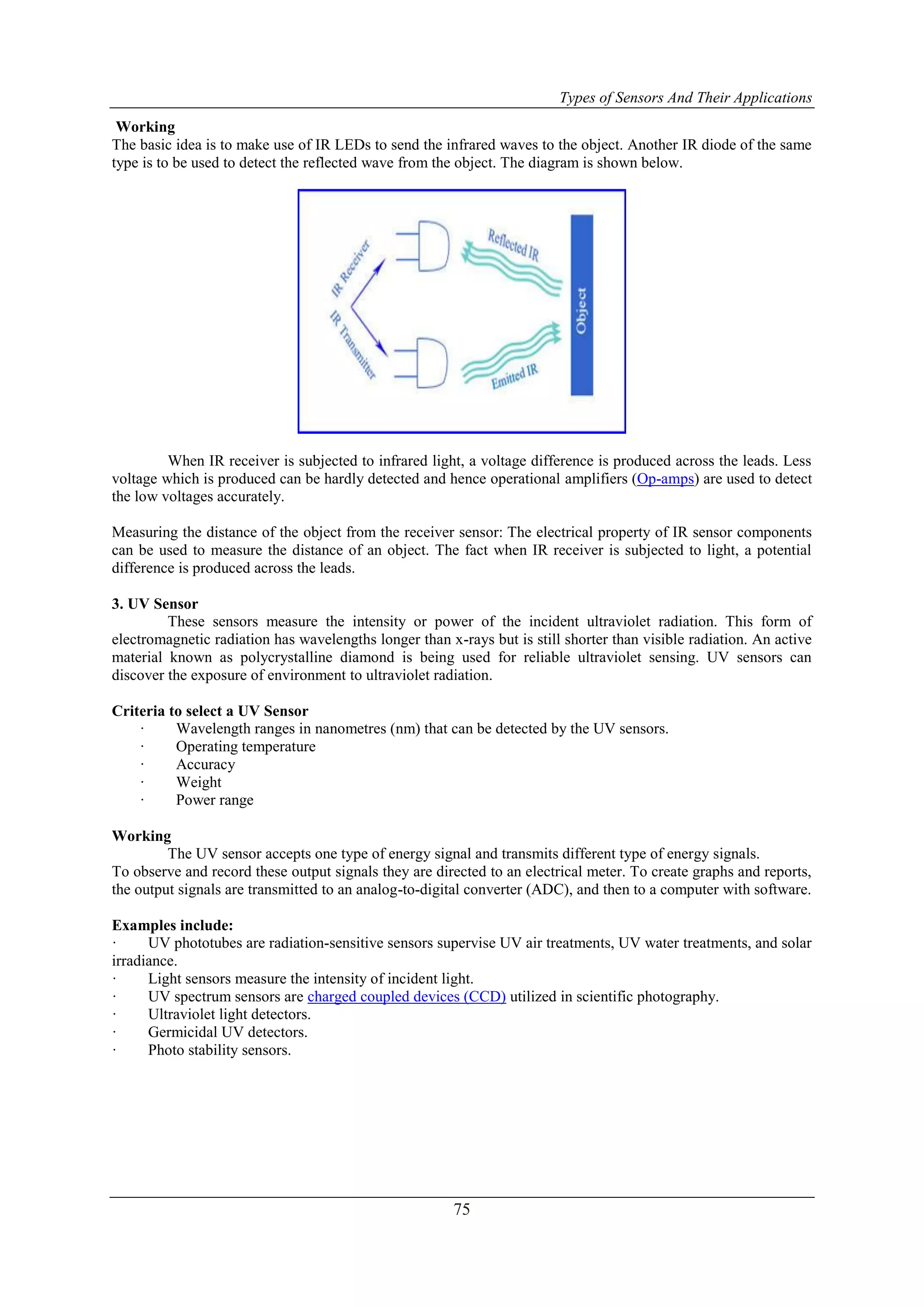
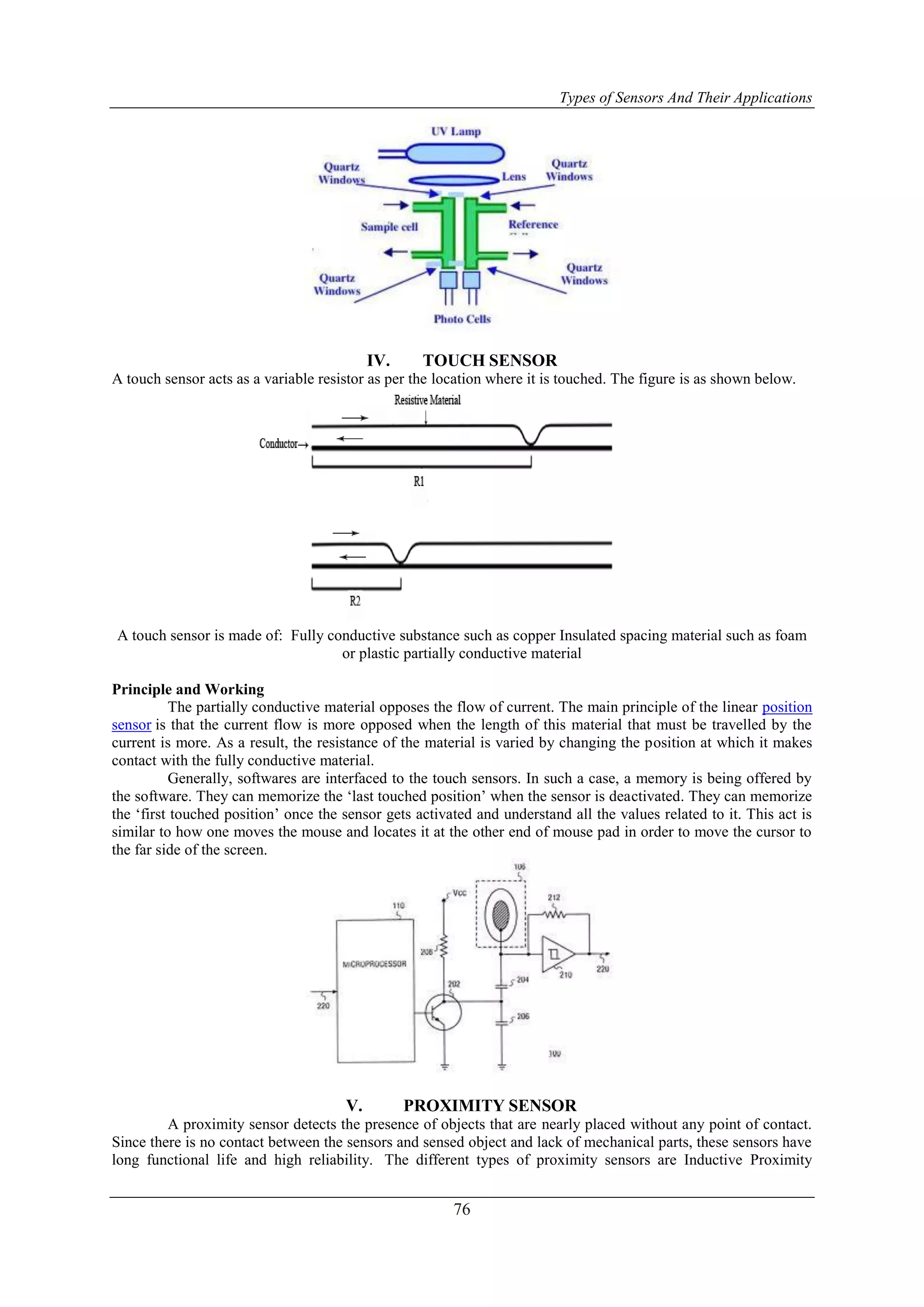
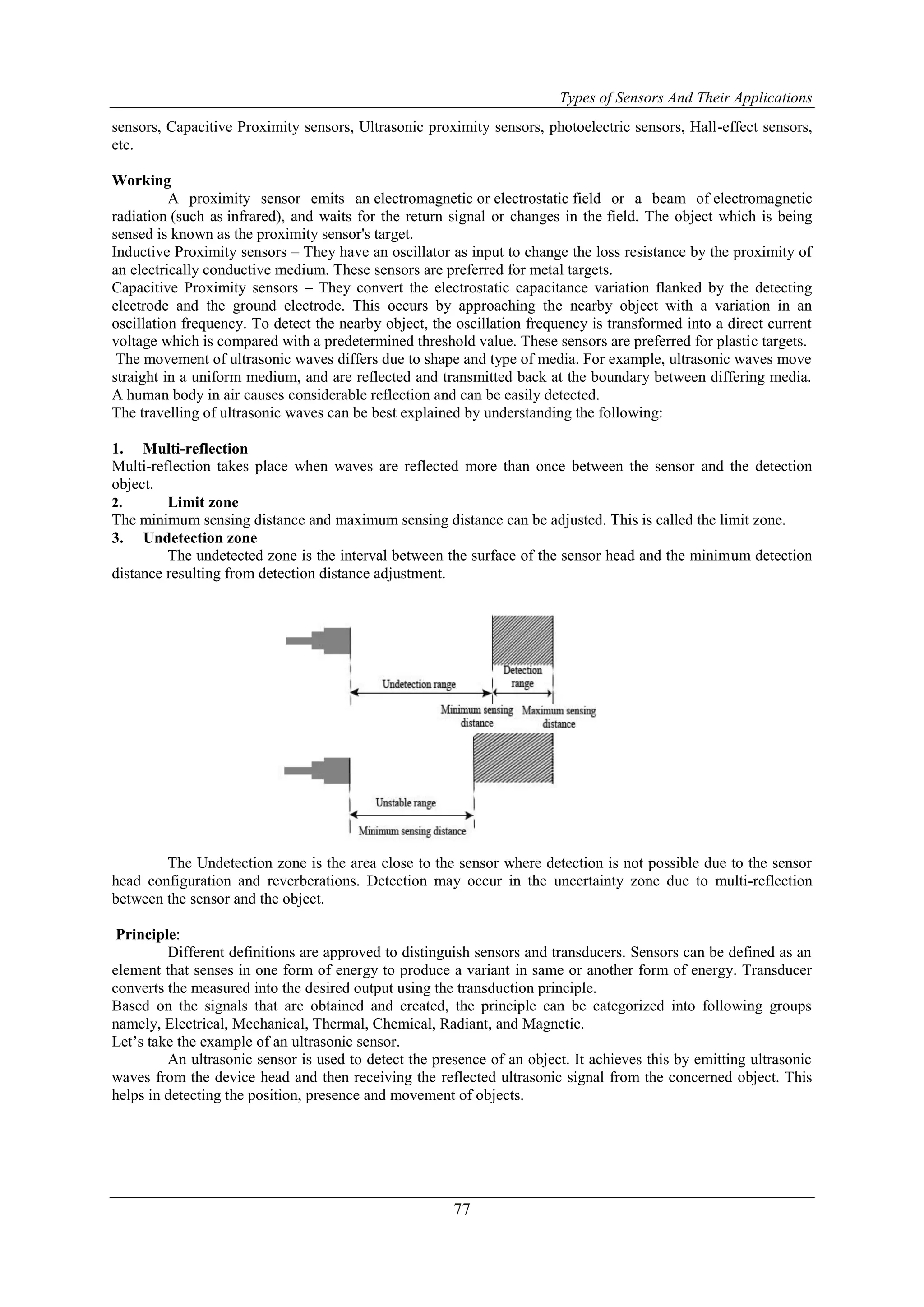
![Types of Sensors And Their Applications
78
Since ultrasonic sensors rely on sound rather than light for detection, it is widely used to measure water-levels,
medical scanning procedures and in the automobile industry. Ultrasonic waves can detect transparent objects
such as transparent films, glass bottles, plastic bottles, and plate glass, using its Reflective Sensors.
6. Advanced Sensor Technology
Sensor technology is used in wide range in the field of Manufacturing. The advanced technologies are as
follows:
1. Bar-code Identification - The products sold in the markets has a Universal Product Code (UPC) which is
a 12 digit code. Five of the numbers signify the manufacturer and other five signify the product. The first six
digits are represented by code as light and dark bars. The first digit signifies the type of number system and the
second digit which is parity signifies the accuracy of the reading. The remaining six digits are represented by
code as dark and light bars reversing the order of the first six digits. Bar code is shown in the figure given below.
The bar code reader can manage different bar code standards even without having the knowledge of the
standard code. The disadvantage with bar coding is that the bar scanner is unable to read if the bar code is
concealed with grease or dirt.
2. Transponders - In the automobile section, Radio frequency device is used in many cases. The
transponders are hidden inside the plastic head of the key which is not visible to anyone. The key is inserted in
the ignition lock cylinder. As you turn the key, the computer transmits a radio signal to the transponder. The
computer will not let the engine to ignite until the transponder responds to the signal. These transponders are
energized by the radio signals. The figure of a transponder is as shown below:
3. Electromagnetic Identification of Manufactured Components - This is similar to the bar code
technology where the data can be coded on magnetic stripe. With magnetic striping, the data can be read even if
the code is concealed with grease or dirt.
4. Surface Acoustic Waves - This process is similar to the RF identification. Here, the part identification gets
triggered by the radar type signals and is transmitted over long distances as compared to the RF systems.
5. Optical Character Recognition - This is a type of automatic identification technique which uses
alphanumeric characters as the source of information. In United States, Optical character recognition is used in
mail processing Centre‟s. They are also used in vision systems and voice recognition systems.
Applications of these sensors:
1. Temperature sensors:
[1] Thermistors](https://image.slidesharecdn.com/h1047285-140507023254-phpapp02/75/International-Journal-of-Engineering-Research-and-Development-7-2048.jpg)
![Types of Sensors And Their Applications
79
Thermistors (thermally sensitive resistors) are available in two types:
NTC (Negative Temperature Coefficient) resistance decreases with rising temperature
PTC (Positive Temperature Coefficient) resistance increases with rising temperature
In both types, the electrical resistance changes with temperature according to a defined curve.
Temp (°C) Resistance (ohm) Temp (°C) Resistance (ohm)
NTC Pt1000 NTC Pt1000
-10 27665 960.9 80 629 1308.9
0 16325 1000.0 90 458.8 1347.0
10 9950 1039.0 100 340.0 1385.0
20 6245 1077.9 110 255.6 1422.9
30 4029 1116.7 120 194.7 1460.6
40 2663 1155.4 130 150.4 1498.2
50 1802 1194.0 140 117.4 1535.8
60 1244 1232.4 150 92.65 1573.1
70 876 1270.7
[2] NTC
The NTCs used by McLaren Electronics are polycrystalline metal oxide ceramic. These precision NTC
elements have a very tight measuring tolerance in a small package, which results in a fast and accurate response.
Near room temperature, these devices offer the greatest sensitivity to temperature differences – an
order of magnitude greater than PTCs or thermocouples. The nominal resistance of the NTC thermistors used in
McLaren Electronics sensors is 5kohm at 25°C. However, the resistance decreases very rapidly with
temperature, making them less suitable for accurate high temperature measurements. Furthermore, the low
resistance at higher temperatures makes the sensors sensitive to the resistance of the harness and connector
contacts.
Because of their high output, NTCs can interface with simple electronic interface circuits as used in
mass market control systems. Our systems have high sensitivity inputs which do not need the high output of an
NTC sensor. However, our systems can interface to NTC sensors, if required.
The Temperature-Resistance function for NTC thermistors is defined as follows:
Temperature (K) = 1 / (A + B*ln[R] + C*[lnR] 3)
R = Resistance of sensor (ohm)
A = 1.28735 x 10-3
B = 0.2357532 x 10-3
C = 94.95448 x 10-9](https://image.slidesharecdn.com/h1047285-140507023254-phpapp02/75/International-Journal-of-Engineering-Research-and-Development-8-2048.jpg)
![Types of Sensors And Their Applications
80
[3] PTC
Platinum (Pt.) thermistors are the most stable temperature sensors in common use today. They are
constructed from a platinum film deposited onto a ceramic substrate. Platinum has been used to measure
temperature for over 100 years. It offers high reliability, long term stability, and rapid response. It is also
insensitive to vibration and thermal shock.
The resistance varies with temperature in a precise fashion. Between 0 and 600°C, this response can be
expressed as an exact mathematical function. Pt. elements are normally supplied with a base resistance of either
100 ohm (Pt100) or 1000 ohm (Pt1000), measured at 0°C.
The Resistance-Temperature transfer function for Pt1000 sensors is defined as follows:
Sensor Resistance (ohm) = 1000 * (1 + ((3.90802x10-3 * T) – (0.5802x10-6 * T2)))
T = Temperature (°C)
[4] Application of NTCs and PTCs
To measure resistance, an electric current has to flow through the element. This generates heat,
resulting in errors. To minimize such errors, the measuring current needs to be kept low (typically less than
1mA). The wires joining the sensing element to the measuring device have their own resistance, which may vary
in unpredictable ways, and so cause further errors. By selecting the sensor resistance to be as large as possible,
both self-heating and lead wire resistance errors can be minimized.
Pt100s exhibit such a small resistance change with temperature that they tend to be overly sensitive to
cable length and connector contact resistance changes. McLaren Electronics offers temperature sensors of all
three types, i.e. NTC, Pt100 and Pt1000. We recommend the use of Pt1000 devices for highest accuracy and
stability. All of our ECUs support Pt1000s as standard, but can be modified to support NTCs and Pt100s.
[5] Sensor Design
In automotive applications, the temperature of a gas (typically air) or a liquid (typically oil, water, fuel,
etc.) needs to be measured. Gases and liquids have very different thermal characteristics, so each medium
requires a different sensor design in order to make accurate temperature measurements.
Heat conducted into the sensor from the surrounding medium alters the temperature of the sensing tip.
Because gases are poor heat conductors and have a very low thermal mass, air temperature sensors must also
have a very low thermal mass. This minimizes errors in measurement and allows a rapid response to changes in
air temperature.
McLaren Electronics air temperature sensors achieve this by exposing the sensor element tip directly to
the air flow, without compromising ruggedness or reliability. Both screw-in and flange mount body styles are
available. Sensors with a flange mount body can be aligned in the air stream to exploit the planar symmetry of
the Pt. elements. This is most important for low velocity air flows, for example if the sensor is located at the end
of a manifold pipe.
With screw-in devices, the point at which the screw thread will tighten cannot be defined exactly. Any
error due to misalignment of the element in the air flow is minimized by careful attention to the design of the
sensor housing.
The fluids used in automotive applications are often aggressive and turbulent. The sensing element
must be isolated from the medium, so the sensor element is encapsulated at the tip of a thermally conductive
housing. This tip is made as small as possible to ensure minimal thermal mass – reducing error and response
time. This package offers a very rugged and accurate method of measuring fluid temperature.](https://image.slidesharecdn.com/h1047285-140507023254-phpapp02/75/International-Journal-of-Engineering-Research-and-Development-9-2048.jpg)
![Types of Sensors And Their Applications
81
[6] Thermocouple
A thermocouple consists of a pair of metals, with different thermo potentials, which are welded
together to form a junction. This junction can be very small, so a thermocouple is easily manufactured into a
small package. When the junction is heated, a voltage is generated which increases with increasing temperature.
Thermocouples are usually used to measure very high temperatures, such as exhaust gas, but may also be used
for lower temperatures. MESL offer both K-type (Chromel/Alumel) and J-type (Iron/Constantan) thermocouples.
The output voltages from these two types of thermocouple are shown below.
Temperature (°C) Output (mV)
J-Type K-Type
0 0 0
100 4.095 5.629
200 8.137 10.779
300 12.207 16.327
400 16.395 21.848
500 20.640 27.393
600 24.902 33.102
700 29.128 39.132
800 33.270 45.494
900 37.325 51.877
1000 41.269
1100 45.108
1200 48.828
For optimum performance the Chromel/Alumel thermocouple wires should be terminated to Alumel
and Chromel contacts within a connector. Thermocouple compensating cable must be used in the harness to
connect to the interface electronics. If copper or copper alloy contacts are used in intermediate connectors,
errors may be introduced which will depend on the temperature difference across the connector pair. These
errors will be negligible if the connector is kept isothermal.
[7] Interface Electronics
The junction is the point of temperature measurement. The other end of each sensor wire needs to be
connected to specialized electronics for reference cold junction compensation. Because the output voltage
changes by just a few microvolts per degree, well designed and well filtered electronics are required,
particularly if used close to an ignition system.
[8] Sensor Design
McLaren Electronics thermocouple sensors are mainly for the measurement of high temperature (up to
approx. 1250°C). The element is surrounded by a stainless steel tube. The diameter of the steel tube has been
selected as a compromise between mechanical robustness (particularly important when measuring exhaust gas](https://image.slidesharecdn.com/h1047285-140507023254-phpapp02/75/International-Journal-of-Engineering-Research-and-Development-10-2048.jpg)
![Types of Sensors And Their Applications
82
temperature) and short response time. The steel tube is electrically isolated from the thermocouple as required
by most cold junction compensation circuits.
[9] Infra-Red
Infra-red sensors measure temperature by detecting the heat radiated from a target which may be some
distance away. Such a non-contact measurement can be used in applications where direct contact with the
medium is difficult, e.g. when measuring the temperature of rotating parts such as a tyre or a brake disc.
[10] Principles of Operation
The Infra-red sensor is a thermoelectric device which converts radiated heat energy into an electrical
potential. The output is non-linear (although it is continuous and repeatable).
0-5V Output: Over the specified target temperature, the sensor gives an output in the 0-5V range.
MES Infra-red sensors obtain all their power from the energy radiated from the target so, in order to
minimize errors, the leakage current drawn by the attached measuring device must not exceed 10nA.
[11] Emissivity
Different materials have a different emissivity, i.e. they radiate different amounts of energy even when
held at the same temperature. Emissivity values are in the range 0 to 1. A perfectly reflecting surface has an
emissivity of 0. Such a surface acts like a mirror in that it reflects an image of its surrounds rather than emitting
its own radiation.
A perfect black body has an emissivity of 1. This kind of surface does not reflect at all, it emits energy
in a characteristic way which depends entirely on its temperature.
All real objects have a lower emissivity than an ideal black body and therefore radiate less energy.
Shiny metal surfaces have a low emissivity, in the region of 0.05 to 0.2, whilst non-metals, organic materials
and coated metals typically have high emissivity, in the range of 0.8 to 0.95. McLaren Electronics offers Infra-
red sensors suitable for the high emissivity range of 0.8 to 0.98.
Emissivity is difficult to measure accurately and it can change with the temperature of the target
surface. This affects the relationship between the temperature of the surface and the amount of energy it radiates.
Unless the sensor reading is interpreted to take the emissivity into account, this appears as a measurement error.
The sensors are sensitive to wavelengths which are much longer than those of visible light, so the color of the
target has little effect.
Please contact McLaren Electronics for assistance in determining the emissivity of your target medium.](https://image.slidesharecdn.com/h1047285-140507023254-phpapp02/75/International-Journal-of-Engineering-Research-and-Development-11-2048.jpg)
![Types of Sensors And Their Applications
83
[12] Failure Modes
The sensor reading will change if the sensitive face becomes dirty or scratched, and care should be
taken to clean the sensors with a suitable, non-aggressive substance. An air purge system can be supplied which
may be used to force air through the linearized output sensor to prevent the accumulation of debris in dirty
environments. For both types of IR temperature sensor the narrow field of view also allows the sensor to be
positioned some distance from the target.
Failure of the sensor may be induced by over temperature of either the sensor or the target, or by static
discharge (if not properly grounded). The mounting arrangement should minimize vibration and prevent the
impact of debris on the sensor.
If an Infra-red sensor is pointed at a very high temperature target, the internal circuits may be
overloaded, causing permanent damage. Please contact McLaren Electronics if you intend to use an Infra-red
sensor in a situation where the target temperature may exceed the temperature stated in the Product Summary.
[13] Applications
Due to its small size and ruggedness, this sensor is ideal for tyre and brake disk temperature measurement.
2. IR sensors
Common applications using InfraTec Pyroelectric infrared detectors include:
• NDIR gas analysis
• IR flame detection
• A variety of analytical instruments for detection of radiation from deep UV to FIR (THz)
• Single and Multi-channel pyrometers
There are also a growing number of diverse applications (some surprising) that use InfraTec thermal
detectors. Please let us know if your application might benefit from our highly stable, high performance, and
highest quality pyroelectric infrared detectors.
GAS DETECTORS / GAS LEAK DETECTION – By mounting a NBP (Narrow Band Pass) filter in
front of our infrared detectors; our device will produce a signal when a pulsed or “chopped” source is used to
illuminate it. The absorption region of CO2 gas is 4.26µm so placing a NBP filter at this spectral region in front
of our device allows it to see only that region. When CO2 gas leaks into the detector‟s Field of View the user
would see a drop in the device signal when the gas absorbs light energy. In some cases a second “Reference”
detector with a 3.95µm filter is used so that the comparison between the two channels gives further evidence of
a leak.
FLAME DETECTION – Hydrocarbon flames emit radiation between 4-4.6µm and the natural 10 Hertz
flickering of any flame is a natural source for our detectors mounted with an “HC” filter. Many clients use this
solution to protect lives at chemical and petroleum plants as well as general building safety.
ALCOHOL TESTING – Another application in the gas detection market is the testing for an illegal level of
alcohol in the breath of a driver. Very accurate readings can be obtained as legal evidence for DWI cases. This
concept is being taken a step further with the discovery that certain illnesses cause gases to form in the lungs
that are not normal, specifically in the case of cancer. By being able to detect certain gases, a quick and
inexpensive method of diagnosis may be possible.
ANESTHESIOLOGY TESTING – Another gas detection application is the use of our detectors to test for the
correct level and mixture of gases used in hospital operating rooms for anesthesiology. Too much, or too little of
one component could be fatal.
PETROLEUM EXPLORATION – A number of companies are using our detectors for high-temperature
down-hole operations as well as topside. Production testing for gas levels below and on the surface is important
to determine if drilling operations are proceeding as planned.
PLANT HEALTH – Imagine having a device that can test the level of CO2 absorption to analyze the health of
plants and check the effect of global warming…it is being done today.
RAIL SAFETY – Testing is underway for a device that will “look” at rail cars to test brake and wheel bearing
temperatures on the move. This is critical, especially for high speed rail in Europe to detect potential failures
before they happen.
SPACE OPERATIONS – InfraTec is qualified by the European Space Agency for use on platforms for Earth
limb detection for satellite orientation and will potentially see applications in LIDAR applications in the future.
UNDERGROUND SOLUTION – The detection of Methane and other gases in mining operations is very
critical to the safety of operations around the world. Many customers use our highly reliable devices to protect
the lives of those that work long hours beneath our feet.](https://image.slidesharecdn.com/h1047285-140507023254-phpapp02/75/International-Journal-of-Engineering-Research-and-Development-12-2048.jpg)
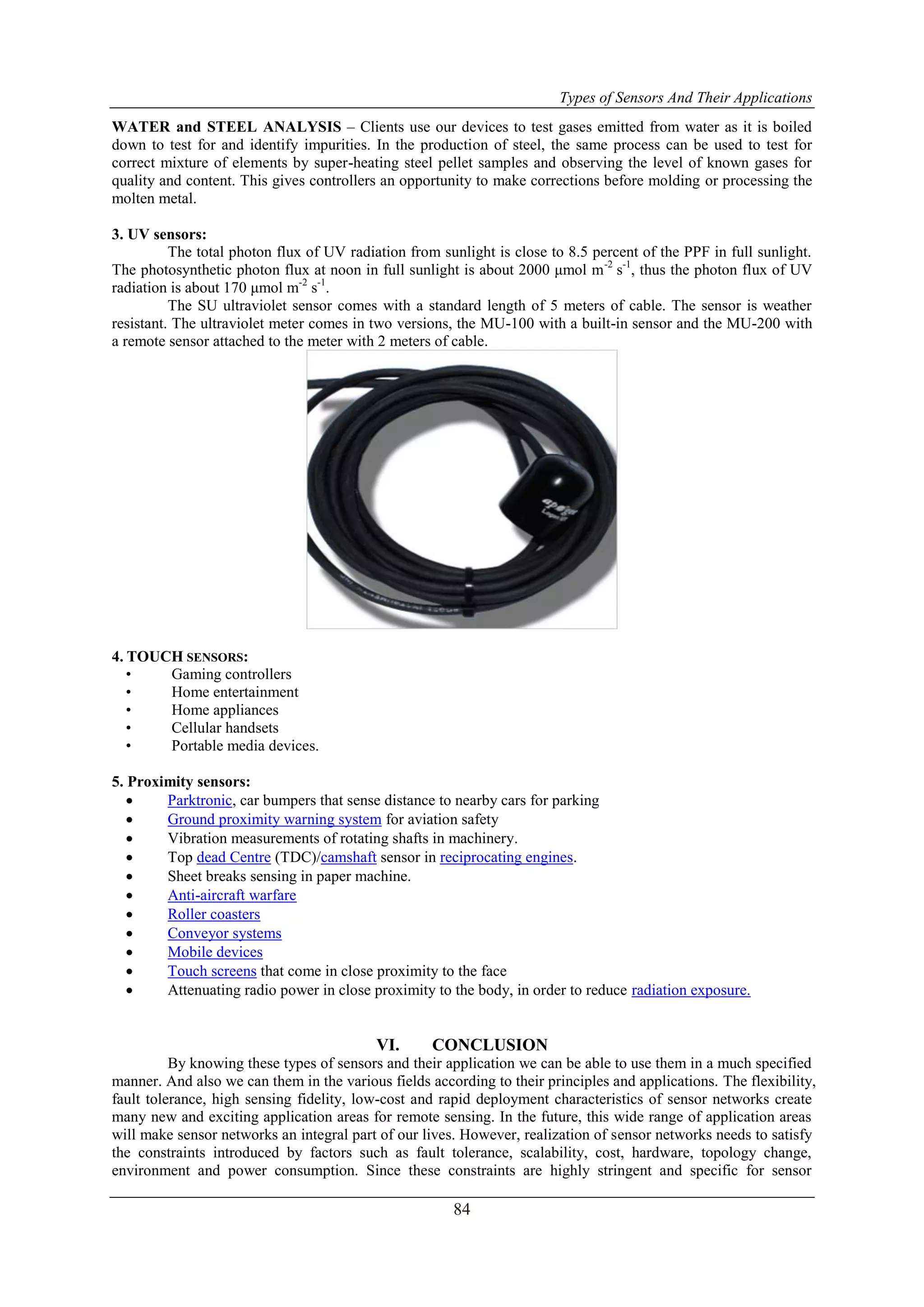
![Types of Sensors And Their Applications
85
networks, new wireless ad hoc networking techniques are required. we encourage more insight into the
problems and more development in solutions to the open research issues as described in this paper.
REFERENCES
[1]. I.F. Akyildiz, W. Su, A power aware enhanced routing (PAER) protocol for sensor networks, Georgia
Tech Technical Report, January 2002, submitted for publication
[2]. A. Bakre, B.R. Badrinath, I-TCP: indirect TCP for mobile hosts, Proceedings of the 15th International
Conference on Distributed Computing Systems, Vancouver, BC, May 1995, pp. 136–143
[3]. P. Bauer, M. Sichitiu, R. Istepanian, K. Premaratne, The mobile patient: wireless distributed sensor
networks for patient monitoring and care, Proceedings 2000 IEEE EMBS International Conference on
Information Technology Applications in Biomedicine, 2000, pp. 17–21
[4]. Bhardwaj, T. Garnett, A.P. Chandrakasan, Upper bounds on the lifetime of sensor networks, IEEE
International Conference on Communications ICC'01, Helsinki, Finland, June 2001
[5]. P. Bonnet, J. Gehrke, P. Seshadri Querying the physical world IEEE Personal Communications
(October 2000), pp. 10–15
[6]. N. Bulusu, D. Estrin, L. Girod, J. HeidemannScalable coordination for wireless sensor networks: self-
configuring localization systems, International Symposium on Communication Theory and
Applications (ISCTA 2001), Ambleside, UK, July 2001
[7]. B.G. Celler et al., An instrumentation system for .the remote monitoring of changes in functional health
status of the elderly, 909
[8]. A. Cerpa, D. Estrin, and ASCENT: adaptive selfconfiguring sensor networks topologies, UCLA
Computer Science Department. 6 A. Cerpa, J. Elson, M. Hamilton, J. Zhao, Habitat monitoring:
application driver for wireless communications technology, ACM SIGCOMM'2000, Costa Rica, April
2001
[9]. A. Chandrakasan, R. Amirtharajah, S. Cho, J.Goodman, G. Konduri, J. Kulik, W. Rabiner, A. Wang,
Design considerations for distributed micro-sensor systems, Proceedings of the IEEE 1999 Custom
Integrated Circuits Conference, San Diego, CA, May 1999, pp. 279–286
[10]. C. Chien, I. Elgorriaga, C. McConaghy, Low-power direct-sequence spread-spectrum modem
architecture for distributed wireless sensor networks, ISLPED'01, Huntington Beach, California, and
August 2001
[11]. “Piezoresistive stress sensors for structural analysis of electronic packages,” J. Electron. Package. vol.
113, no. 3, pp. 203–215, 1991.](https://image.slidesharecdn.com/h1047285-140507023254-phpapp02/75/International-Journal-of-Engineering-Research-and-Development-14-2048.jpg)